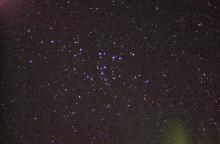Listen to today's episode of StarDate on the web the same day it airs in high-quality streaming audio without any extra ads or announcements. Choose a $8 one-month pass, or listen every day for a year for just $30.
You are here
Big Jellyfish
A cosmic jellyfish floats through a giant cluster of galaxies. It has a twisting “tentacle” that’s 200,000 light-years long — a trail of gas that’s given birth to hundreds of thousands of stars.
Galaxy D100 is in the Coma Cluster, a collection of thousands of galaxies. It’s classified as a “jellyfish” galaxy. Astronomers have discovered dozens of them. All of them are wide, thin disks, with tentacles of gas dangling behind them. And all of them are members of big clusters.
A galaxy turns into a jellyfish as gravity pulls it toward the center of a cluster at millions of miles per hour. The falling galaxy plows through massive amounts of gas between the cluster’s galaxies. That forces gas out of its own disk. The gas forms long ribbons behind the galaxy — the tentacles of the jellyfish. Gas in the tentacles clumps together, giving birth to bright new stars and setting the tentacles aglow.
D100 began forming its tentacle about 300 million years ago. As gas was ripped from its disk, star formation shut down in the disk and began in the tentacle. Stars are being born in clumps that are a few hundred light-years wide. The largest clump is just outside the disk, and contains about 200,000 stars.
The Coma Cluster is in the constellation Coma Berenices, which is high in the sky at nightfall. D100 is plunging toward the center of the cluster, leaving a trail of young stars behind it.
Script by Damond Benningfield





